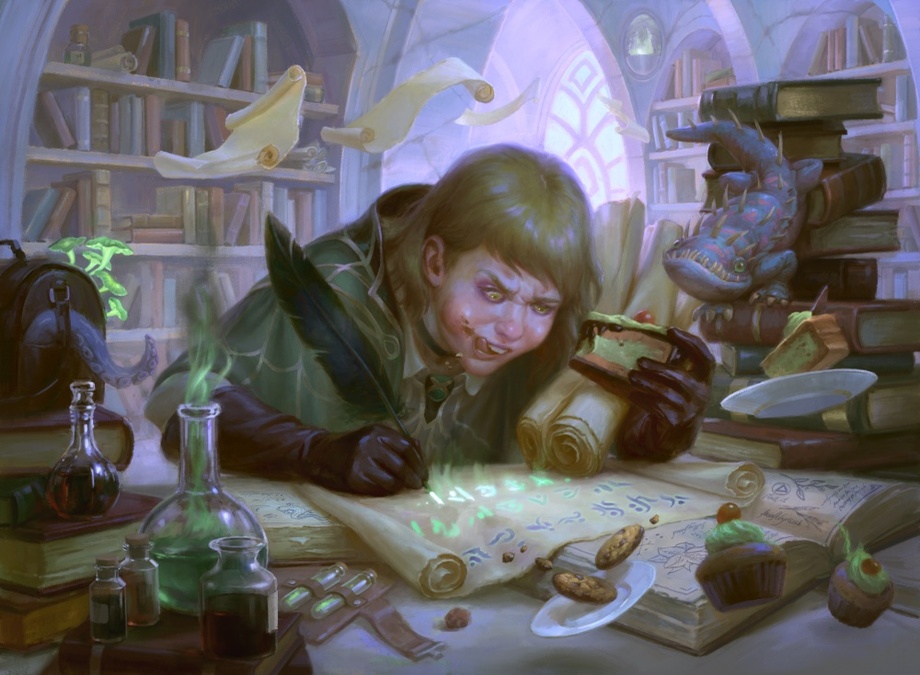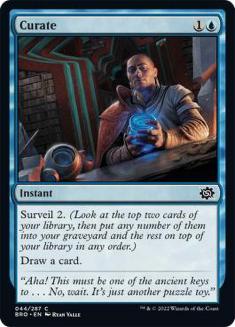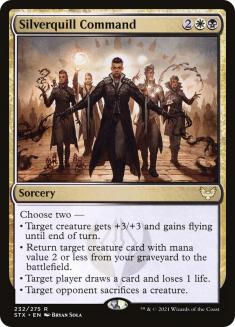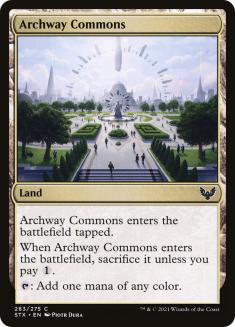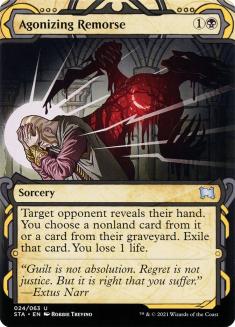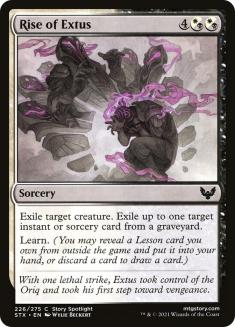This upcoming weekend will feature the second Sealed Open on Magic Arena, this time using Strixhaven. If you’re thinking about competing, here are the things I think you should know.
Best-of-One or Best-of-Three?
The first question many players ask is whether they should play Best-of-One or Best-of-Three. Fortunately, I’ve already written about this is my article about the previous Sealed Open, so you can review that for a detailed answer, but broadly, if you enjoy one more than the other, I think you should choose it. If you don’t care and your goal is to play the second day, you should play Best-of-One. If you believe you’re a relatively skilled sealed player and want to maximize your gem equity, you might prefer Best-of-Three.
Building Your Sealed Deck
Once you’ve entered the queue, you’ll get a Sealed pool. Then you need to build a deck, so let’s talk about doing that.
Choose Your Interface
First off, there’s the question of how you want to physically build your deck. The Arena deckbuilder has some nice features, like the ability to use the search bar to filter your card pool in a lot of different ways, but it also doesn’t display your entire card pool on a single screen, so there are some tradeoffs.
If you don’t like the Arena deckbuilder, you can click 40 random cards to save a deck, exit to the event page, and click the “Add to Decks” button. Then navigate to your Decks tab, highlight the deck you’ve just added, and click Export. That will copy your deck to your clipboard. If you’d prefer a deckbuilding interface more like Magic Online, I recommend SealedDeck.Tech. Open that link and then you can click Paste Deck and paste the deck you’ve copied.
If seeing everything at once isn’t a priority for you, you can just use the deckbuilder in Arena.
First Looks
After I open a pool, I like to start by looking at my rares and mythics to see if anything stands out. Then I examine my Lessons, primarily checking to see whether I have Environmental Sciences, but noting the others as well. Next I check my lands and artifacts, specifically looking for Campus Guide and Letter of Acceptance.
It’s not that I think those are particularly strong cards, but they tell me what kind of options I have when it comes to constructing a manabase. If I don’t have fixing, I’ll be limited to two colors and a splash. If I have an Environmental Sciences, an Archway Commons, some Campuses, and a fixing artifact or two, I can think about just playing all my good cards. Once I know what my mana allows, that determines the rest of my process.
Pick Your Pair
If my fixing is weak, I look through the gold cards to see if there are strong pulls toward any particular pair. Then check my monocolored cards. At this point I’m trying to identify my strongest color pair, which will usually be one of the five supported colleges, but it’s worth considering off-college pairs. In Draft, you’ll generally want to stick to drafting a college because you don’t know what cards you’ll see, and you’ll have access to more possible cards if you draft a college than an off-college pair, but in Sealed, there’s no mystery about what you might see, as you know all the cards you have, so it’s worth considering that you can just play your red and green cards if they’re the best cards you have. Often, but not always, you will want to at least splash their shared gold pair, blue in this case.
When considering which color pair you’ll play when you have bad fixing, the first priority is to make sure you have enough playable cards. For most Sealed pools, there will be some pairs where you simply can’t cast enough spells, or filling out your deck would involve playing a lot of cards that you really shouldn’t be playing.
If you’re not sure which cards those are, I’d recommend checking the Game In Hand win rate on 17Lands.com for any card that doesn’t look great, and if playing a color pair would force you to play cards with a below 50% GIH WR, I’d consider that a meaningful strike against that pair and look to see if you have a viable build without such weak cards (note that the average GIH WR on 17Lands in Sealed is 55% (remember to adjust your filters to show the stats for Sealed, as it will default to showing Premiere Draft), so 50% is actually quite bad.
If you have multiple pairs that offer enough playable cards, your top priority is maximizing your bombs. Again, the stats can tell you which cards these are if you’re not sure. Some powerful-looking cards aren’t as strong as they appear, so it’s worth making sure cards your drawn to actually perform well. In general, anything with a GIH WR over 60% is worth making special note of.
Finding Flaws
If you still don’t have a clear best deck, consider the possible flaws with each deck, and what they might lose to. Some major possible flaws:
- Lack of removal. Either you just don’t have enough ways to interact with your opponent’s cards in general, or you can’t interact with a certain class of card, such as creatures with high toughness. This can be a dealbreaker, especially if your deck is slow. The faster your deck is, the less important it is to be able to answer everything, and the more you can substitute combat tricks for removal.
- A bad curve. If too many of your cards cost the same amount of mana, you likely won’t be able to use your mana efficiently over the course of a game. This means you’ll generally fall behind, which is often a death sentence. You want to make sure you have enough cheap plays, but also, if your curve is too low, make sure your deck isn’t generally too low-impact to win games. Make sure you have a plan about what will happen that will let you win.
- A bad Lesson fit. Lessons are an essential component of Strixhaven Limited, and a lot of the cards that learn are deceptively powerful, but only if you have good Lessons for them to find. It’s especially important to have access to a few Summonings, the Lessons that make creature tokens, so if you have several of those Lessons that your colors don’t let you cast, try to find a way to can take advantage of them.
Still Can’t Decide?
When in doubt, Silverquill.
As of writing, straight Silverquill decks without a splash have 34% of all match wins recorded by 17Lands in Sealed, and 30% of all match losses. It’s the most commonly played and most successful pair, so there’s a good chance any given pool should end up there. That doesn’t mean you should just play whatever Silverquill cards you have, but if your pool doesn’t offer any clear direction and you have a reasonable Silverquill deck, it’s a fine fallback.
This also means that more of your opponents will be playing Silverquill than other decks, so prepare for that. What does that mean? Well, in general, Silverquill decks play cheap creatures, flyers, and removal, and play a tempo-oriented rather than attrition-based gameplan. This means cheap removal is a more reliable plan than trying to block, since you’ll play against decks that both have evasion and can use removal spells or Study Break to clear your blockers. It also means that if you’re trying to play defensive creatures, you must have a plan to deal with flying creatures in particular.
When You Have Good Fixing
Now, to get back to how I approach a pool with good fixing. First, if I have a lot of overlapping Campuses, I’ll prioritize those colors. I’ll still follow a process that’s similar to the weak fixing situation, but also consider splashes that take advantage of the Campuses.
If I have Environmental Sciences, the next thing to do is to type “learn” in the search bar. Any card that comes up now counts as a potential piece of mana fixing, which is particularly relevant for cards that cost one to three mana. If I have four or five of those in a color pair, I can safely splash any third color into any deck of that color pair.
If I have multiple strong color fixers (Archway Commons, Letter of Acceptance, Cultivate), then I’ll also consider a “good stuff” approach. Here, instead of comparing my color pairs, I just start by adding my best cards to a deck until I get to around 18-25 cards, and then start fine-tuning.
If there are any colors where I’m only playing one to three cards, I ask if those cards are worth supporting an extra color for. I identify my base colors and smooth out my curve, generally by filling in with cheap plays from my base colors.
Once I know what I’m trying to cast, I verify that my mana works. I make sure I have eight or nine lands that let me cast spells of my primary color or two, and make sure I have good support for any other splashes. This is a little tricky, as the exact number changes depending on stuff like how much pressure you’re putting on a single Environmental Sciences to fix multiple colors of mana.
This approach doesn’t always result in building a five-color deck. Often a pool will naturally pare itself down, but this is a good way to make sure you’ve considered all your best cards. If it does lead to a four- or five-color deck, you should just note that possibility and still try to build a two-color deck to compare it to, but also, when building two-color decks, keep your best cards in mind and remember that your pool allows you to splash if you want to, so you might keep any true bombs in any deck you look at.
Adjusting to Sealed from Draft
If you’re more familiar with Strixhaven Draft than Strixhaven Sealed, you should be aware of a few cards that perform substantially better in Sealed, at least according to 17Lands.com’s data, so avoid overlooking anything.
First off, discard spells perform way better in Sealed. In Draft, Humiliate is great, Go Blank is okay, and Agonizing Remorse, Duress, and especially Inquisition of Kozilek perform poorly. In Sealed, all of them except Inquisition of Kozilek are good enough that you should generally include them in black decks.
Similarly, as is traditional in Sealed, counterspells are quite a bit better, since it’s so important to answer opposing bombs. Negate in particular is far better in Sealed, and the gap between Negate and Test of Talents widens, presumably because you’re much more likely to play against the rares that Negate hits and Test of Talents misses.
I’d also like to note Rise of Extus, which is a great card in general but the best common in Strixhaven Sealed. It’s particularly important to pay attention to because the hybrid cost means you can use it in three of the five colleges. Making use of any copies that I open is a considerable priority for me.
I have personally found that I’m somewhat more likely to play aggressive decks in Strixhaven Sealed than I am in Strixhaven Draft, but that probably says more about my drafting than it says about Sealed. Still, I definitely think this is a format where the old Sealed wisdom applies. If your pool is lacking in bombs, late-game, or interaction, or generally has any holes in it, the best solution is just to kill your opponents before those weaknesses come up. Building an aggressive deck is a reliable way to get the most out of a weak pool.
Don’t Rely on Synergy
My previous statements about the importance of playing to the battlefield, particularly having two-mana plays in Strixhaven Limited still very much apply. Also, I’ve generally found most explicit synergies in Strixhaven such as lifegain, +1/+1 counters, and sacrifice (all present in Witherbloom), and removing things from your graveyard to each be relatively unsupported and unsuccessful, and the same holds true, likely more so, in Sealed, where removal is even more plentiful and good at breaking up any synergies you do manage to assemble.
As a final note, if you haven’t played a lot of Strixhaven Limited, one thing to be aware of is that your creature count will often be much lower than it is in other Limited formats, and that’s nothing to worry about. As long as you have a Lesson or two that make creatures, all your learn cards can function as additional threats. Maximize your Lessons by prioritizing learn cards and choosing colors that let you cast your best Lessons.

